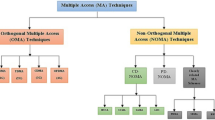Abstract
In this paper, we propose an adaptive NOMA OMA protocol that uses the best protocol between OMA and NOMA in order to maximize the total instantaneous throughput. Adaptive NOMA OMA will allow up to 1.8 dB gain compared to that of NOMA. Furthermore, adaptive NOMA OMA will offer up to 2.7 dB gain with respect to OMA. We also consider a hybrid NOMA/OMA transmission technique where some users use NOMA, and the rest of users are using OMA. We use NOMA to transmit data to K users, while OMA is employed to transmit data to the remaining \(N-K\) users. The optimal value of K is determined as well as the set of NOMA and OMA users in order to maximize the total instantaneous throughput. For a throughput of 8 bit/s/Hz, adaptive NOMA OMA hybrid will offer 10 dB gain with respect to NOMA.










Similar content being viewed by others
References
Li, Q.C., Niu, H., Papathanassiou, A.T., Wu, G.: 5G network capacity: key elements and technologies. IEEE Veh. Technol. Mag. 9(1), 71–78 (2014)
Saito Y., Benjebbour A., Kishiyama Y., Nakamura T.: System- level performance evaluation of downlink non-orthogonal multiple access (NOMA). In: Proceeding IEEE International Symposium Personal, Indoor Mobile Radio Communnication (PIMRC), pp. 611–615 (2013)
Ding, Z., Peng, M., Poor, H.V.: Cooperative non-orthogonal multiple access in 5G systems. IEEE Commun. Lett. 19(8), 1462–1465 (2015)
Ding, Z., Dai, H., Poor, H.V.: Relay selection for cooperative NOMA. IEEE Commun. Lett. 5(4), 416–419 (2016)
Men, J., Ge, J.: Non-orthogonal multiple access for multiple-antenna relaying networks. IEEE Commun. Lett. 19(10), 1686–1689 (2015)
Niu, Y., Gao, C., Li, Y., Su, L., Jin, D.: Exploiting multi-hop relaying to overcome blockage in directional mmwave small cells. J. Commun. Netw. 18(3), 364–374 (2016)
Kim, J.B., Lee, I.H.: Non-orthogonal multiple access in coordinated direct and relay transmission. IEEE Commun. Lett. 19(11), 2037–2040 (2015)
Zhong, C., Zhang, Z.: Non-orthogonal multiple access with co- operative full-duplex relaying. IEEE Commun. Lett. 20(12), 2478–2481 (2016)
Yuanwe, L., Zhiguo, D., Elkashlan, M., Poor, H.V.: Cooperative non-orthogonal multiple access with simultaneous wireless information and power transfer. IEEE J. Selec. Areas Commun. 34(4), 938–953 (2016)
Varshney L.: Transporting information and energy simultaneously. In: Proceeding IEEE Internaiotnal Symposium Information Theory (ISIT), pp. 1612–1616, (2008)
Xinwei, Y., Yuanwei, L., Shaoli, K., Arumugam, N.: Performance analysis of NOMA with fixed gain relaying over Nakagami-m fading channels. IEEE Access 5, 5445–5454 (2017)
Jinjin, M., Jianhua, G.: Performance analysis of non-orthogonal multiple access in downlink cooperative network. IET Commun. 9(18), 2267–2273 (2015)
Liu, Y., Ding, Z., Elkashlan, M., Yuan, J.: Non-orthogonal multiple access in large-scale underlay cognitive radio networks. IEEE Trans. Veh. Technol. 65(12), 10152–10157 (2016)
Bhattacharjee, S., Acharya, T., Bhattacharya, U.: NOMA inspired multicasting in cognitive radio networks. IET Commun. 12(15), 1845–1853 (2018)
Liu, M., Song, T., Gui, G.: Deep cognitive perspective: resource allocation for NOMA based heterogeneous IoT with imperfect SIC. IEEE Inter. Things J. 6, 2885–2894 (2018)
Lei, X., Zhou, Y., Wang, P., Liu, W.: Max–min resource allocation for video transmission in NOMA-based cognitive wireless networks. IEEE Trans. Commun. 66(11), 5804–5813 (2018)
Bin, L., Xiaohui, Q., Kaizhi, H., Zesong, F., Fuhui, Z., Hu, R.Q.: Security-reliability tradeoff analysis for cooperative NOMA in cognitive radio networks. IEEE Trans. Commun. 67(1), 83–96 (2019)
Wang, D., Men, S.: Secure energy efficiency for NOMA based cognitive radio networks with nonlinear energy harvesting. IEEE Access 6, 62707–62716 (2018)
Zhou F., Chu Z., Sun H., Leung V.C.M.: Resource allocation for secure MISO-NOMA cognitive radios relying on SWIPT. In: IEEE International Conference Communications (ICC), pp. 20-24 (2018)
Sun, H., Zhou, F., Hu, R.Q., Hanzo, L.: Robust beamforming design in a NOMA cognitive radio network relying on SWIPT. IEEE J. Selec. Areas Commun. 37(1), 142–155 (2019)
Amini, M.R., Baidas, M.W.: Random-access NOMA in URLL energy-harvesting iot networks with short packet and diversity transmissions. IEEE Access 8, 220734–220754 (2020)
Gupta P., Ghosh D.: Channel assignment with power allocation for sum rate maximization in NOMA cellular networks. In: 5th International Conference Computing, Communication and Security (ICCCS), Bihar, pp. 14–16 (2020)
Agarwal, A., Chaurasiya, R., Sudhakar, R., Aditya, K.J.: Outage probability analysis for NOMA downlink and uplink communication systems with generalized fading channels. IEEE Access 8, 220461–220481 (2020)
Xu, P., Wang, Y., Chen, G., Pan, G., Ding, Z.: Design and evaluation of buffer-aided cooperative NOMA with direct transmission in IoT. IEEE Inter. Things J, Early Access (2020)
Proakis, J.: Digital Communications, 5th edn. Mac Graw-Hill, New York (2007)
Author information
Authors and Affiliations
Corresponding author
Additional information
Publisher's Note
Springer Nature remains neutral with regard to jurisdictional claims in published maps and institutional affiliations.
Appendix A
Appendix A
The cumulative distribution function (CDF) of the equivalent SINR at i-th NOMA user is given by
By a derivative, we deduce the PDF of the equivalent SINR at i-th NOMA user
Therefore, \(f(\gamma _{\mathrm{NOMA}}(i))\) given in (19) and (22) is equal to
Rights and permissions
About this article
Cite this article
Alhamad, R. Adaptive NOMA/OMA for wireless communications. SIViP 15, 1469–1475 (2021). https://doi.org/10.1007/s11760-021-01879-5
Received:
Revised:
Accepted:
Published:
Issue Date:
DOI: https://doi.org/10.1007/s11760-021-01879-5




